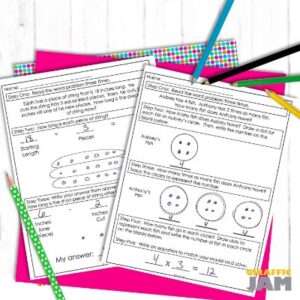
Teaching grade-level math to special education students can be challenging. Your students who are working on below grade-level skills struggle to understand the new content. But, we often find ourselves in the position that these students still have to be exposed to the general education math curriculum. Particularly schools that teach math using the inclusion model, it is so hard to find the appropriate resources are below-grade level students need. How can we teach our special education students the same math concepts that the general education students are learning? The answer: modification, differentiation, and scaffolding.
In my district, all but 1% of the student population is fully included in the general education classroom. For me personally, I’ve only had 2 students in my entire teaching career that were on an alternate curriculum. The rest of my caseload had to master grade-level content. So, when you create modified worksheets always start with the standards. What exactly is every student in your grade-level expected to master? Which standards are priority standards and which are supporting standards? What about limits? Learn everything you can about the grade-level standards and use that information to guide everything you do.

Look carefully at the image. Notice the scaffolds I built in? On the page on the left, I have some of the comparison sentence written, and (although you can’t see it) there’s a ‘cheat sheet’ chart that helps them know how many place value positions they’ve moved. And, since I gave them space to draw a model they can use more concrete strategies to work on an abstract concept.
The page on the right has the area model already filled out across the top and sides. This increases the chance of success, because they don’t have to worry about making errors in setting up the problem. And the table at the bottom helps keep everything lined up! When you teach special education math, it’s so important to have scaffolds built in to make it easier for your students to be successful.
Don’t limit yourself to only teaching math during math class. As you are creating resources, think about when you can use them. Could you use them as a morning work activity? Would you be able to send them home as homework? Do you have a staff member who could pull a small group of students to work for 10 minutes before lunch? The more you expose students to the content, the higher likelihood of them being successful. In my experience, ten minutes of extra practice every day is better than 50 minutes of extra practice once a week.
This one is purely personal choice, but in my room we don’t do ‘cutesy’. And here’s why. I teach 4th and 5th grade students. Unless the entire class is doing a worksheet covered in puppies and dog bones, I’m not passing out a worksheet to my special education students that is covered in puppies and bones. 99.99999% of the time, my students have already figured out that they struggle with math or reading. The know that they aren’t working on the same skills as their peers. They are frustrated that it takes them 15 minutes to solve a math problem that Susie can solve in 2 minutes. I refuse to further embarrass my students by patronizing them with baby-work. When I created these math worksheets, there is no clipart (other than necessary models) and the formatting and text choices are appropriate for 4th and 5th grade students.

When you create your activities, design them with your families in mind. Raise your hand if you’ve ever had a parent say “I don’t know how to do this”. What if I told you, that modified math worksheets are the perfect idea for homework because your parents can use the scaffolds to help them without embarrassment. Because, let’s face it, a lot of parents don’t want to admit that they don’t understand their 9-year old child’s homework. But, if you send these home then ALL parents can understand how to complete the activities. And, it’s in a non-threatening way since all parents will receive them. Bonus points: since the scaffolds are there, parents will be working with their child using the same strategy and vocabulary that you are using – no more having kids show up the next day trying to use some hack a grown-up saw on TikTok.
I know it can be scary to try something new. And, it can be daunting to create resources yourself. If you want to skip the creation process, check out what two buyers have said about my special education math resources.

“No other resource was as helpful as this one! If your students are struggling, search no further: you’ve found the best source for scaffolding in a logical and kid-friendly way!”
– Jennifer D.
“This was so helpful for me to find something to fit each and every student with varying abilities and backgrounds without starting from scratch each time.”
– Anna H.

What do you think? Do you already use something similar in your classroom? Let me know in the comments!
2 Responses
I’m looking for something to use in math for my 4th & 5th grade Sped students. I would love to try these!
I’m so glad to hear it! Let me know how they work for you and your students 🙂